Exploring the Drivers for Changes in Lake Area in a Typical Arid Region during Past Decades
Abstract
:1. Introduction
2. Study Sites and Materials
2.1. Study Sites
2.2. Study Materials
3. Methodology
3.1. Calculation of TWVF and Sublimation
3.2. SWAT Model
3.3. Multi-Resolution Analysis (MRA) Method
4. Results
4.1. Spatial Distribution of Variations in Lake Area and Water-Cycle Components
4.2. The Relationships between Lake Area and Lake Water-Cycle Components
4.3. Different Methods to Analyze the Key Factors Influencing Lake Area Changes
4.3.1. Phase Analysis on Average
4.3.2. Linear Trends Analysis
4.3.3. MRA Trends Analysis
4.4. The Role of Lake Water Cycle Components in Lake Water Balance
4.5. Effects of Temperature and Solar Radiation on TWVF
5. Discussion
5.1. Comparison with Other Literature Results
5.2. Effects of Other Components on Lake Area
5.3. Uncertainty in TWVF
6. Conclusions
- (a)
- The river inflow in all three open lakes showed an overall increasing trend of 0.045 ± 0.031 × 108 m3 yr−1. Regarding the TWVF, Bosten Lake exhibited an overall increasing trend, while Ulungur Lake, Ebinur Lake, and Sayram Lake experienced decreasing trends. The lake ice sublimation and lake surface precipitation showed increasing trends in the four lakes. The river outflow from Bosten Lake showed a clear upward trend (0.108 ± 0.021 × 108 m3 yr−1).
- (b)
- The influencing factors on the change in lake area varied for different phases and lake types. Overall, river inflow was the dominant factor affecting the change in open lake areas, while lake surface precipitation was the primary factor affecting the change in closed lake areas. The TWVF and river outflow, as the primary factors contributing to lake water loss, had a significant impact on the lake areas in subsequent years.
- (c)
- The average amount of river inflow, TWVF, lake ice sublimation, lake surface precipitation, and river outflow in the four lakes was 17.41 × 108 m3 yr−1, 6.60 × 108 m3 yr−1, 0.41 × 108 m3 yr−1, 0.98 × 108 m3 yr−1, and 9.12 × 108 m3 yr−1, respectively. The TWVF and lake ice sublimation, which were the components of lake water cycle with no observed values in the four lake surfaces, played an important role in influencing changes in lake area in dry years. The water balance analysis revealed that Ulungur Lake encountered periods with a river inflow that was lower than the TWVF, while Bosten Lake and Ebinur Lake had certain years where the total lake ice sublimation exceeded total lake surface precipitation.
Supplementary Materials
Author Contributions
Funding
Data Availability Statement
Conflicts of Interest
References
- Xu, F.; Dawson, R.W.; Tao, S.; Cao, J.; Li, B.G. A method for lake ecosystem health assessment: An Ecological Modeling Method (EMM) and its application. Hydrobiologia 2001, 443, 159–175. [Google Scholar] [CrossRef]
- Kosamu, I.B.M.; Makwinja, R.; Kaonga, C.C.; Mengistou, S.; Kaunda, E.; Alamirew, T.; Njaya, F. Application of DPSIR and Tobit Models in Assessing Freshwater Ecosystems: The Case of Lake Malombe, Malawi. Water 2022, 14, 619. [Google Scholar] [CrossRef]
- Luo, M.; Liu, T.; Meng, F.H.; Duan, Y.C.; Bao, A.M.; Xing, W.; Feng, X.W.; De Maeyer, P.; Frankl, A. Identifying climate change impacts on water resources in Xinjiang, China. Sci. Total Environ. 2019, 676, 613–626. [Google Scholar] [CrossRef]
- Wang, W.; Samat, A.; Ma, L.; Ge, Y.; Abuduwaili, J. Spatio-temporal variations and trend analysis of lake area in Xinjiang in 1986–2019. Acta Ecol. Sin. 2022, 42, 1300–1314. [Google Scholar] [CrossRef]
- Fu, C.; Wu, H.; Zhu, Z.; Song, C.; Xue, B.; Wu, H.; Ji, Z.; Dong, L. Exploring the potential factors on the striking water level variation of the two largest semi-arid-region lakes in northeastern Asia. CATENA 2021, 198, 105037. [Google Scholar] [CrossRef]
- Zhang, Y.; Long, A.; Lv, T.; Deng, X.; Wang, Y.; Pang, N.; Lai, X.; Gu, X. Trends, Cycles, and Spatial Distribution of the Precipitation, Potential Evapotranspiration and Aridity Index in Xinjiang, China. Water 2023, 15, 62. [Google Scholar] [CrossRef]
- Dong, T.; Liu, J.; Liu, D.; He, P.; Li, Z.; Shi, M.; Xu, J. Spatiotemporal variability characteristics of extreme climate events in Xinjiang during 1960–2019. Environ. Sci. Pollut. Res. 2023, 30, 57316–57330. [Google Scholar] [CrossRef] [PubMed]
- Ma, L.; Wu, J.L.; Liu, W.; Abuduwaili, J. Distinguishing between anthropogenic and climatic impacts on lake size: A modeling approach using data from Ebinur Lake in arid northwest China. J. Limnol. 2014, 73, 350–357. [Google Scholar] [CrossRef]
- Rahimi, A.; Breuste, J. Why is Lake Urmia Drying up? Prognostic Modeling With Land-Use Data and Artificial Neural Network. Front. Environ. Sci. 2021, 9, 603916. [Google Scholar] [CrossRef]
- Plug, L.J.; Walls, C.; Scott, B.M. Tundra lake changes from 1978 to 2001 on the Tuktoyaktuk Peninsula, western Canadian Arctic. Geophys. Res. Lett. 2008, 35, L03502. [Google Scholar] [CrossRef]
- Zhou, J.; Wang, L.; Zhang, Y.; Guo, Y.; Li, X.; Liu, W. Exploring the water storage changes in the largest lake (Selin Co) over the Tibetan Plateau during 2003–2012 from a basin-wide hydrological modeling. Water Resour. Res. 2016, 51, 8060–8086. [Google Scholar] [CrossRef]
- Zhang, G.; Yao, T.; Chen, W.; Zheng, G.; Shum, C.; Yang, K.; Piao, S.; Sheng, Y.; Yi, S.; Li, J.; et al. Regional differences of lake evolution across China during 1960s-2015 and its natural and anthropogenic causes. Remote Sens. Environ. 2019, 221, 386–404. [Google Scholar] [CrossRef]
- Qi, C.; You, B.; Chang, Y. Analysis of water quality verification and monitoring results of Bosten Lake. Arid Environ. Monit. 2019, 33, 159–162. [Google Scholar]
- Ji, F.; Shen, J.; Ma, X.; Xiong, L.; Sun, X.; Sun, L. Analysis on water quality changes and causes of Wulungu Lake. J. Hydroecol. 2018, 39, 61–66. [Google Scholar] [CrossRef]
- Xin, H.; Chen, Z.; Wu, L. Water quality status and nutrition assessment of Ebinur Lake. J. Salt Lake Res. 2010, 18, 30–34. [Google Scholar]
- Luan, H. Temporal and Spatial Distribution of Main Physical and Chemical Factors and Water Quality Evaluation of Sailimu Lake. Master’s Thesis, Dalian Ocean University, Dalian, China, 2014. [Google Scholar]
- Yang, L. Effect of Hydrometeorological Elements Change on Water Level of Bosten Lake in Yanqi Basin. Master’s Thesis, Lanzhou University, Lanzhou, China, 2019. [Google Scholar]
- Li, Y.; Chen, Y.; Zhang, Q.; Fang, G. Analysis of the change in water level and its influencing factors on Bosten Lake from 1960 to 2018. Arid Zone Res. 2021, 38, 48–58. [Google Scholar] [CrossRef]
- Zhai, M.; Gao, F.; Liu, K.; Jiang, F. Characteristics and Attribution Identification of Runoff Variation in the Source Area of Ulungur River Based on the Budyko Hypothesis. Water Resour. Power 2023, 41, 44–48. [Google Scholar] [CrossRef]
- Wei, B. Dynamic Change of Ebinur Lake Area in Recent 45 Years Research on Its Driving Mechanism. Master’s Thesis, Shandong University of Science and Technology, Qingdao, China, 2018. [Google Scholar]
- Bayinzhahan; Zhang, D. Exploring the method of determining the minimum ecological water level in the Sailimu Lake basin in Xinjiang. Ground Water 2020, 42, 182–185. [Google Scholar] [CrossRef]
- Wu, H.W.; Fu, C.S.; Zhang, C.C.; Zhang, J.M.; Wei, Z.W.; Zhang, X.P. Temporal Variations of Stable Isotopes in Precipitation from Yungui Plateau: Insights from Moisture Source and Rainout Effect. J. Hydrometeorol. 2022, 23, 39–51. [Google Scholar] [CrossRef]
- Cao, Y.; Fu, C.; Wu, H.; Wu, H.; Zhang, H.; Yang, M.; Ji, Z.; Yu, M.; Dong, L. Exploring Methods to Estimate Ice Sublimation and Total Water Vapor Flux of Large Lakes in China. J. Geophys. Res. Atmos. 2023, 127, e2022JD037095. [Google Scholar] [CrossRef]
- Fisher, R.A.; Wieder, W.R.; Sanderson, B.M.; Koven, C.D.; Oleson, K.W.; Xu, C.G.; Fisher, J.B.; Shi, M.J.; Walker, A.P.; Lawrence, D.M. Parametric Controls on Vegetation Responses to Biogeochemical Forcing in the CLM5. J. Adv. Model. Earth Syst. 2019, 11, 2879–2895. [Google Scholar] [CrossRef]
- Kay, J.E.; Deser, C.; Phillips, A.; Mai, A.; Hannay, C.; Strand, G.; Arblaster, J.M.; Bates, S.C.; Danabasoglu, G.; Edwards, J.; et al. The Community Earth System Model (CESM) large ensemble project A Community Resource for Studying Climate Change in the Presence of Internal Climate Variability. Bull. Am. Meteorol. Soc. 2015, 96, 1333–1349. [Google Scholar] [CrossRef]
- Lawrence, D.M.; Fisher, R.A.; Koven, C.D.; Oleson, K.W.; Swenson, S.C.; Bonan, G.; Collier, N.; Ghimire, B.; van Kampenhout, L.; Kennedy, D.; et al. The Community Land Model Version 5: Description of New Features, Benchmarking, and Impact of Forcing Uncertainty. J. Adv. Model. Earth Syst. 2019, 11, 4245–4287. [Google Scholar] [CrossRef]
- DeRepentigny, P.; Jahn, A.; Holland, M.M.; Smith, A. Arctic Sea Ice in Two Configurations of the CESM2 During the 20th and 21st Centuries. J. Geophys. Res. Ocean. 2020, 125, e2020JC016133. [Google Scholar] [CrossRef]
- Katul, G.G.; Oren, R.; Manzoni, S.; Higgins, C.; Parlange, M.B. Evapotranspiration: A process driving mass transport and energy exchange in the soil-plant-atmosphere-climate system. Rev. Geophys. 2012, 50, RG3002. [Google Scholar] [CrossRef]
- McVicar, T.R.; Roderick, M.L.; Donohue, R.J.; Li, L.; Van Niel, T.G.; Thomas, A.; Grieser, J.; Jhajharia, D.; Himri, Y.; Mahowald, N.M.; et al. Global review and synthesis of trends in observed terrestrial near-surface wind speeds: Implications for evaporation. J. Hydrol. 2012, 416, 182–205. [Google Scholar] [CrossRef]
- Arnold, J.G.; Srinivasan, R.; Muttiah, R.S.; Williams, J.R. Large area hydrologic modeling and assessment—Part 1: Model development. J. Am. Water Resour. Assoc. 1998, 34, 73–89. [Google Scholar] [CrossRef]
- Neitsch, S.L.; Arnold, J.G.; Kiniry, J.R.; Williams, J.R. Soil and Water Assessment Tool Theoretical Documentation Version 2005; Texas Water Resources Institute: Temple, TX, USA, 2006. [Google Scholar]
- Arnold, J.G.; Moriasi, D.N.; Gassman, P.W.; Abbaspour, K.C.; White, M.J.; Srinivasan, R.; Santhi, C.; Harmel, R.D.; van Griensven, A.; Van Liew, M.W.; et al. SWAT: Model use, Calibration, and Validation. Trans. ASABE 2012, 55, 1491–1508. [Google Scholar] [CrossRef]
- Fu, C.S.; James, A.L.; Yao, H.X. SWAT-CS: Revision and testing of SWAT for Canadian Shield catchments. J. Hydrol. 2014, 511, 719–735. [Google Scholar] [CrossRef]
- Fu, C.S.; Lee, X.; Griffis, T.J.; Baker, J.M.; Turner, P.A. A Modeling Study of Direct and Indirect N2O Emissions From a Representative Catchment in the US Corn Belt. Water Resour. Res. 2018, 54, 3632–3653. [Google Scholar] [CrossRef]
- King, K.W.; Arnold, J.G.; Bingner, R.L. Comparison of Green-Ampt and curve number methods on Goodwin Creek Watershed using SWAT. Trans. ASABE 1999, 42, 919–925. [Google Scholar] [CrossRef]
- Kannan, N.; Santhi, C.; Williams, J.R.; Arnold, J.G. Development of a continuous soil moisture accounting procedure for curve number methodology and its behaviour with different evapotranspiration methods. Hydrol. Process. 2008, 22, 2114–2121. [Google Scholar] [CrossRef]
- Mallat, S.G. A theory for multiresolution signal decomposition—The wavelet representation. IEEE Trans. Pattern Anal. Mach. Intell. 1989, 11, 674–693. [Google Scholar] [CrossRef]
- Martinez, B.; Amparo Gilabert, M. Vegetation dynamics from NDVI time series analysis using the wavelet transform. Remote Sens. Environ. 2009, 113, 1823–1842. [Google Scholar] [CrossRef]
- Fu, C.; James, A.L.; Yao, H. Investigations of uncertainty in SWAT hydrologic simulations: A case study of a Canadian Shield catchment. Hydrol. Process. 2015, 29, 4000–4017. [Google Scholar] [CrossRef]
- Wu, H.; Wang, N.; Jiang, X.; Guo, Z. Variations in water level and glacier mass balance in Nam Co lake, Nyaincientanglha range, Tibetan Plateau, based on ICESat data for 2003-09. Ann. Glaciol. 2014, 55, 239–247. [Google Scholar] [CrossRef]
- Gao, F.; He, B.; Yan, Z.; Xue, S.; Li, Y. Analysis of the changes and driving force of the water area in the Ulungur Lake over the past 40 years. J. Water Supply Res. Technol.-Aqua 2020, 69, 500–511. [Google Scholar] [CrossRef]
- Ge, X. Analysis of Lake Surface Change and Natural Driving Factors in Ebinur Lake Based on Machine Learning in Recent 30a. Master’s Thesis, Xinjiang University, Urumqi, China, 2019. [Google Scholar]
- Chai, H.X.; Cheng, W.M.; Zhou, C.H.; Zhao, S.M.; Liu, H.J. Climate effects on an inland alpine lake in Xinjiang, China over the past 40 years. J. Arid Land 2013, 5, 188–198. [Google Scholar] [CrossRef]
- Liu, L. Analysis of the Hydrological Characteristics and Water Balance of Bosten Lake. Master’s Thesis, Sichuan Normal University, Chengdu, China, 2012. [Google Scholar]
- Yang, C. Analysis calculation on water and balance of Aibi Lake. Arid Land Geogr. 1990, 4, 36–39. [Google Scholar] [CrossRef]
- Zhang, H. An Integrated Modeling of Groundwater-Surface Water Interaction in the Kaidu River Basin. Master’s Thesis, Nanjing University, Nanjing, China, 2016. [Google Scholar] [CrossRef]
- Wang, Y.; Liu, Z.; Yao, J.; Bayin, C. Effect of Climate and Land Use Change in Ebinur Lake Basin during the Past Five Decades on Hydrology and Water Resources. Water Resour. 2017, 44, 204–215. [Google Scholar] [CrossRef]
- Box, J.E.; Steffen, K. Sublimation on the Greenland Ice Sheet from automated weather station observations. J. Geophys. Res. Atmos. 2001, 106, 33965–33981. [Google Scholar] [CrossRef]
- Zuo, H.; Chen, B.; Wang, S.; Guo, Y.; Zuo, B.; Wu, L.; Gao, X. Observational study on complementary relationship between pan evaporation and actual evapotranspiration and its variation with pan type. Agric. For. Meteorol. 2016, 222, 1–9. [Google Scholar] [CrossRef]
- Liu, Y. Soil Alteration and Water Loss in the Tarim River Basin. J. Hydroecol. 2022, 43, 105–112. [Google Scholar] [CrossRef]
- Wang, Z.; Cheng, T.; Liu, K.; Jiang, H. Water resources and its features in Ulungur River Watershed, Xinjiang. Arid Land Geogr. 2000, 23, 123–128. [Google Scholar] [CrossRef]
- Dai, J. Study on changes of runoff and sediment content in Boltala River Basin, Xinjiang. Heilongjiang Sci. Technol. Water Conserv. 2014, 42, 35–36. [Google Scholar] [CrossRef]
- Li, Y.; Chu, X.; Jin, H. Study on changes of hydrological characteristics of Ebinur Lake Basin in Xinjiang. J. China Hydrol. 2006, 5, 68–71. [Google Scholar]

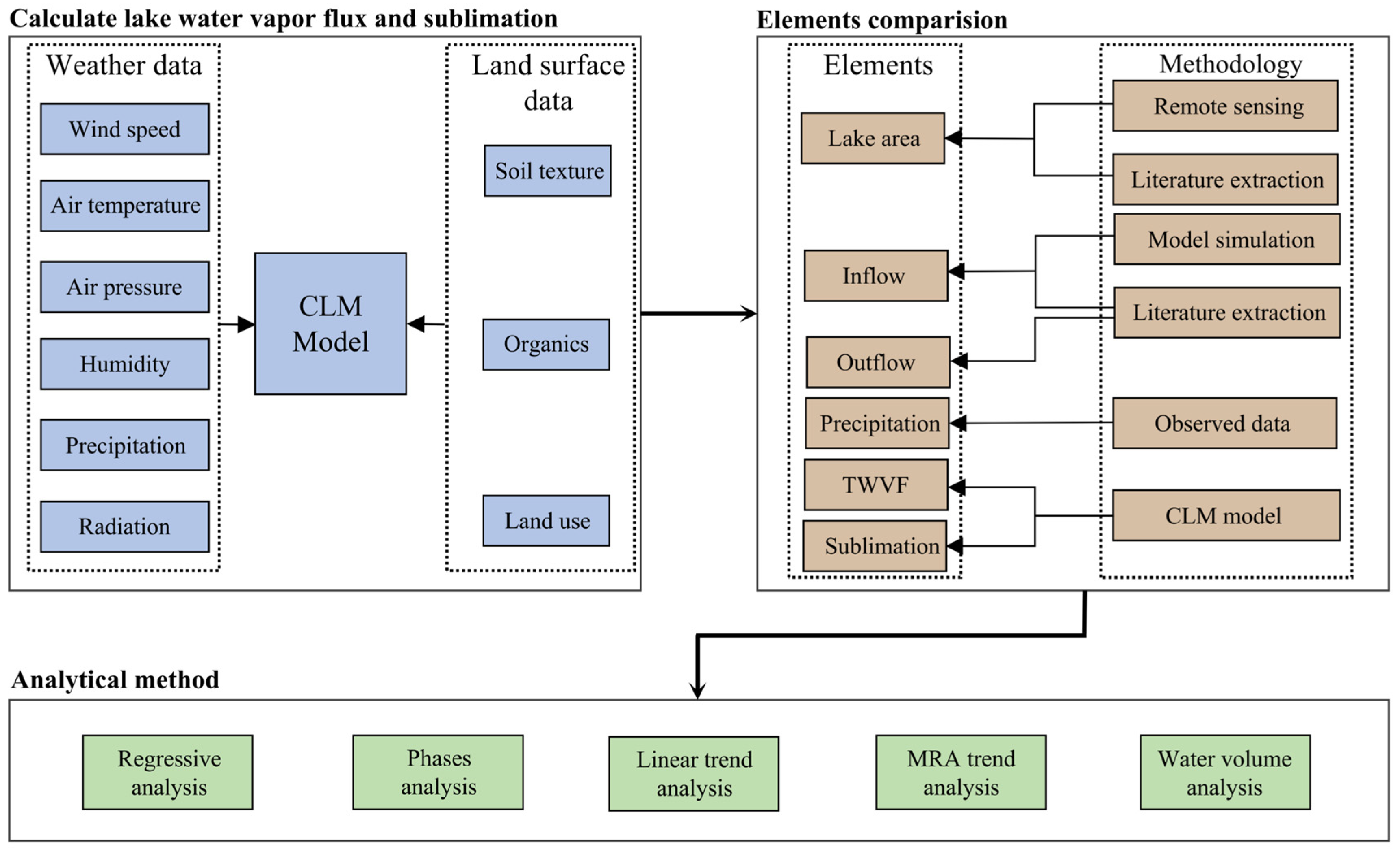
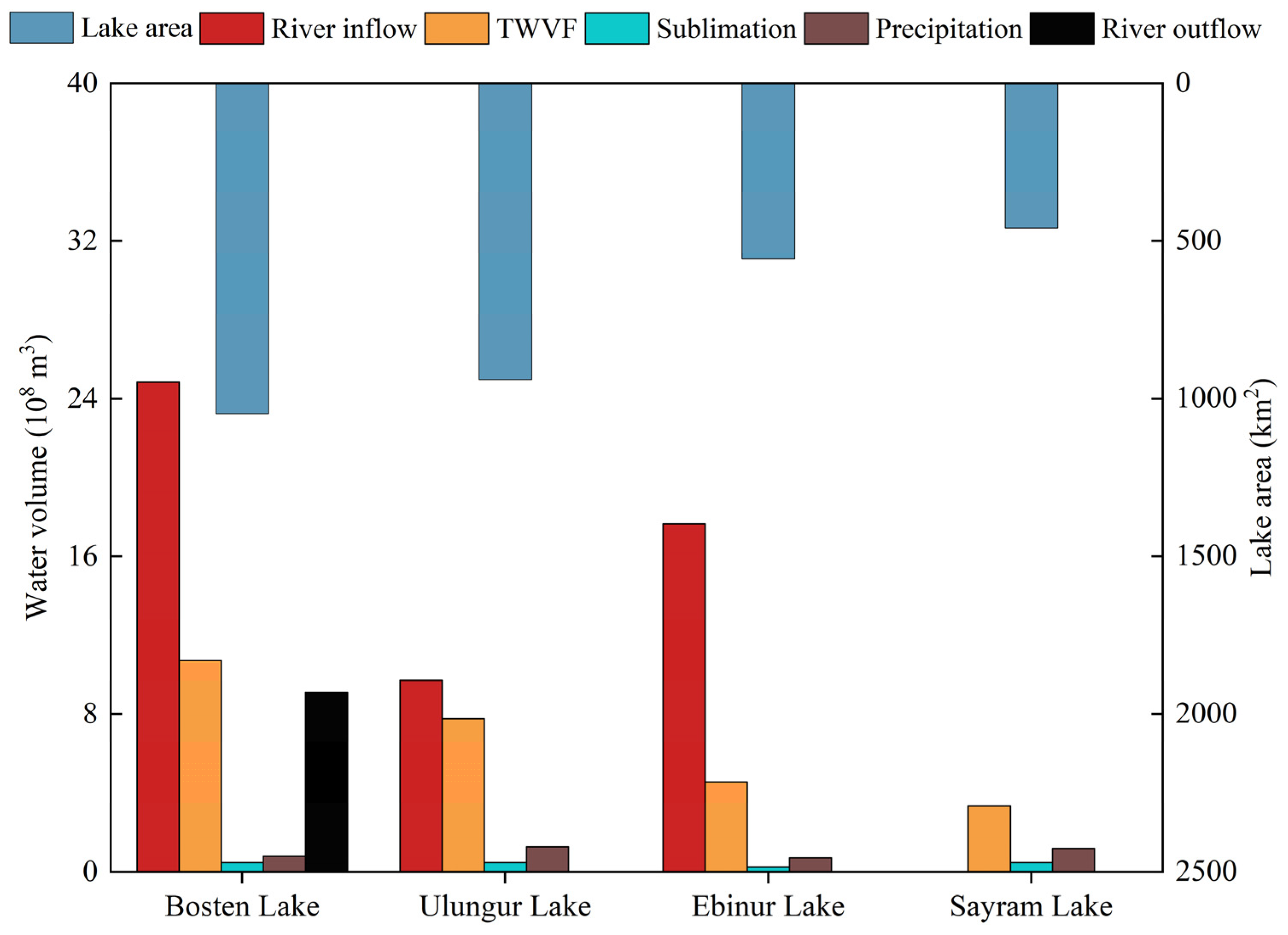
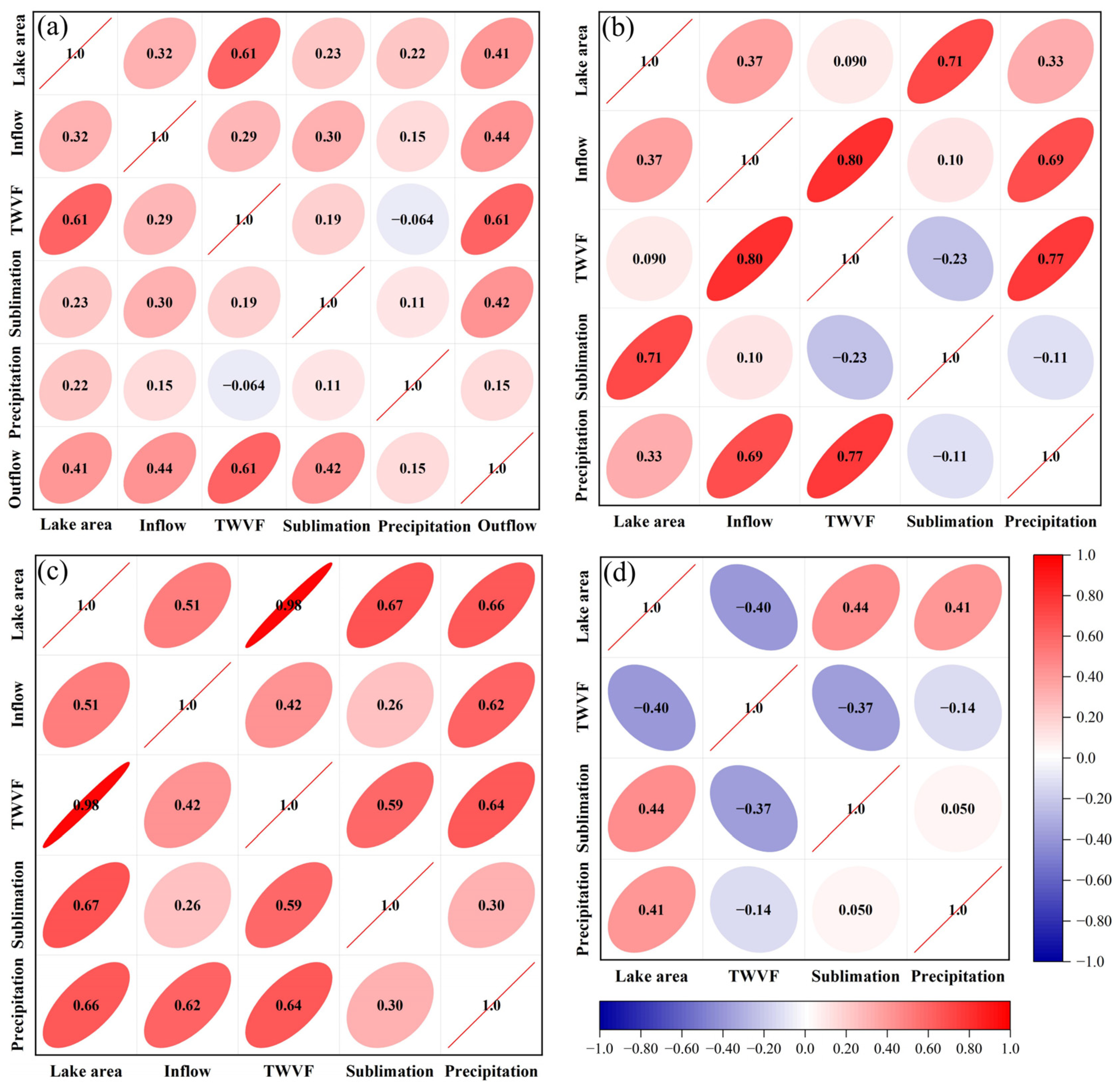

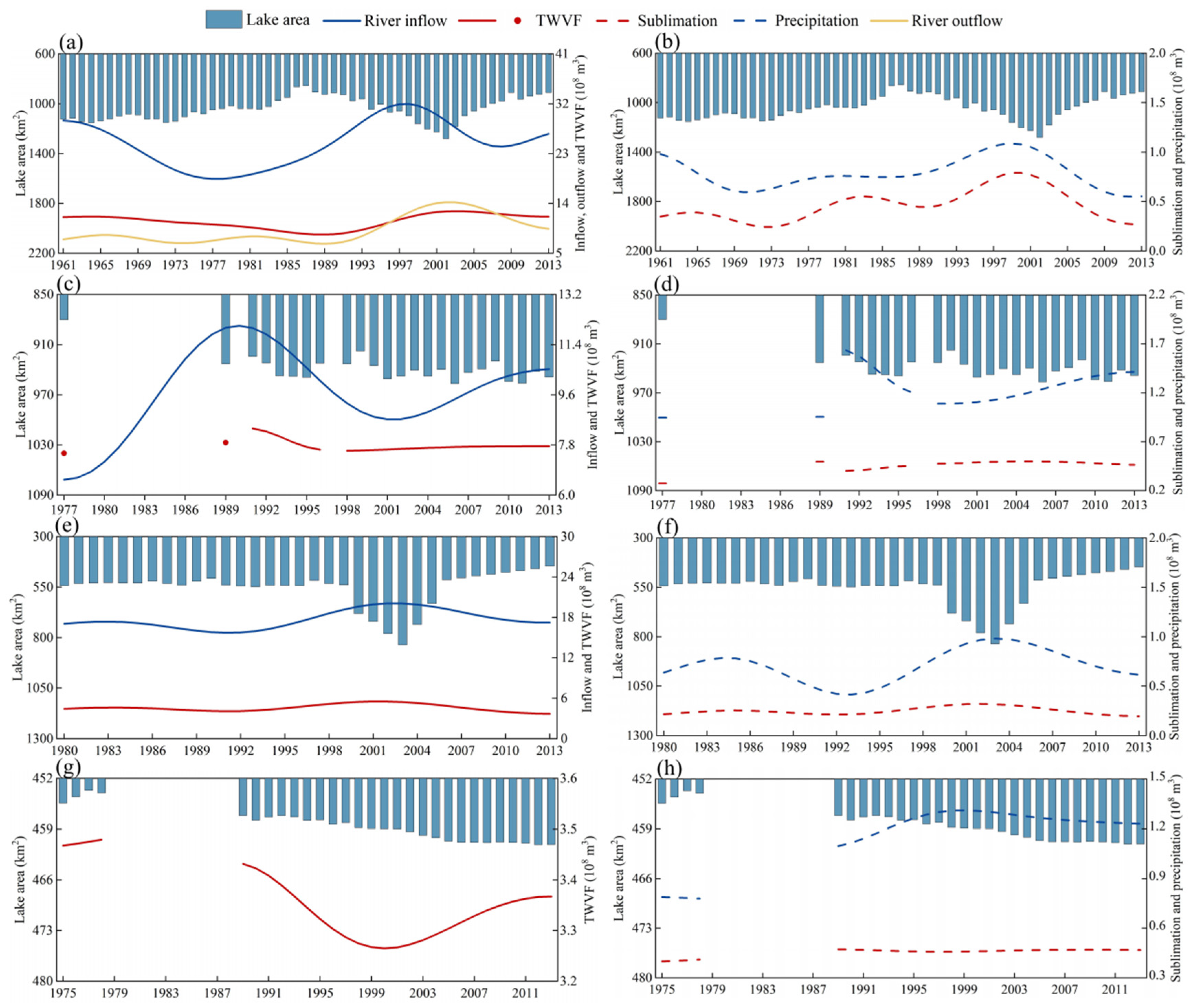

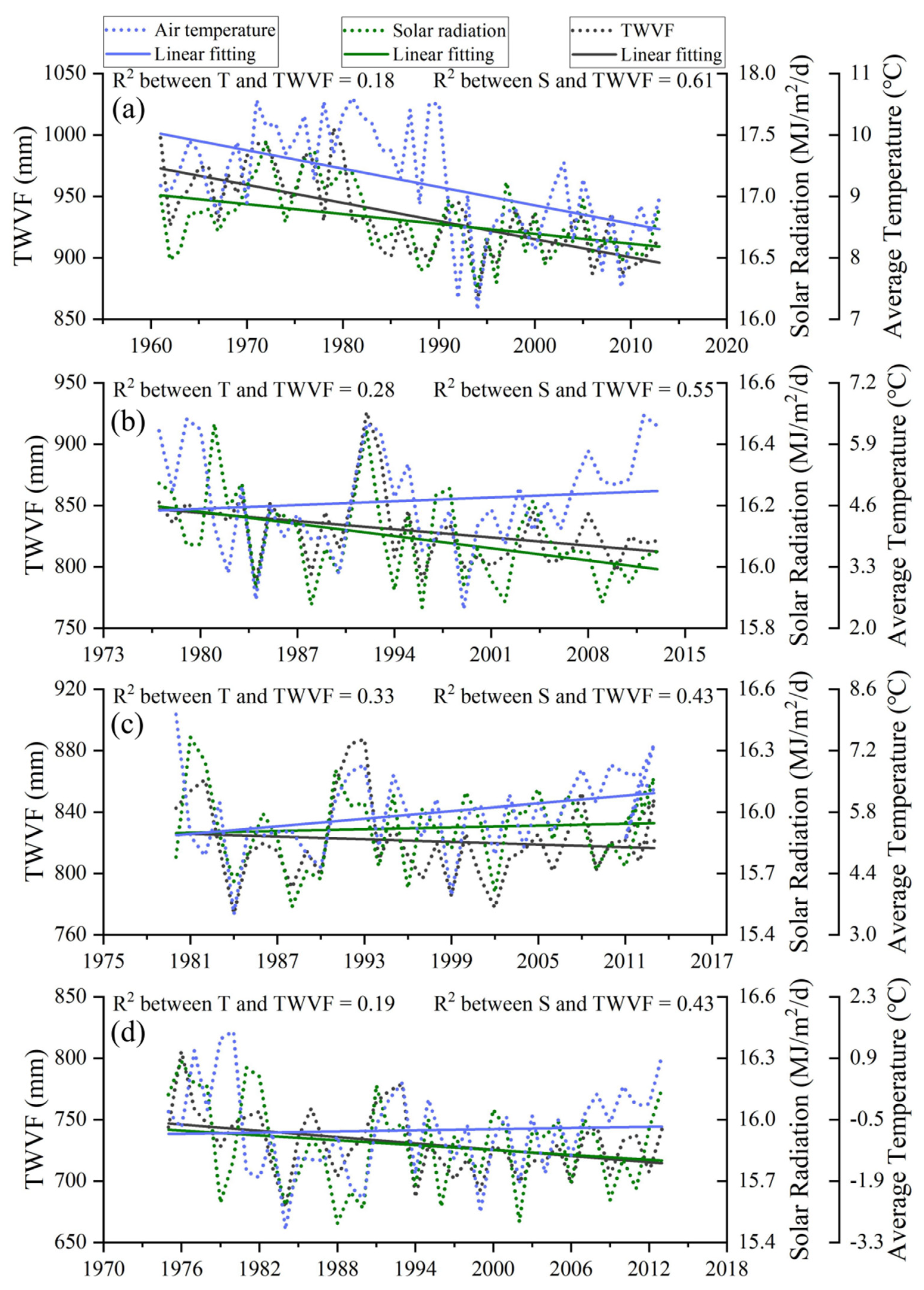
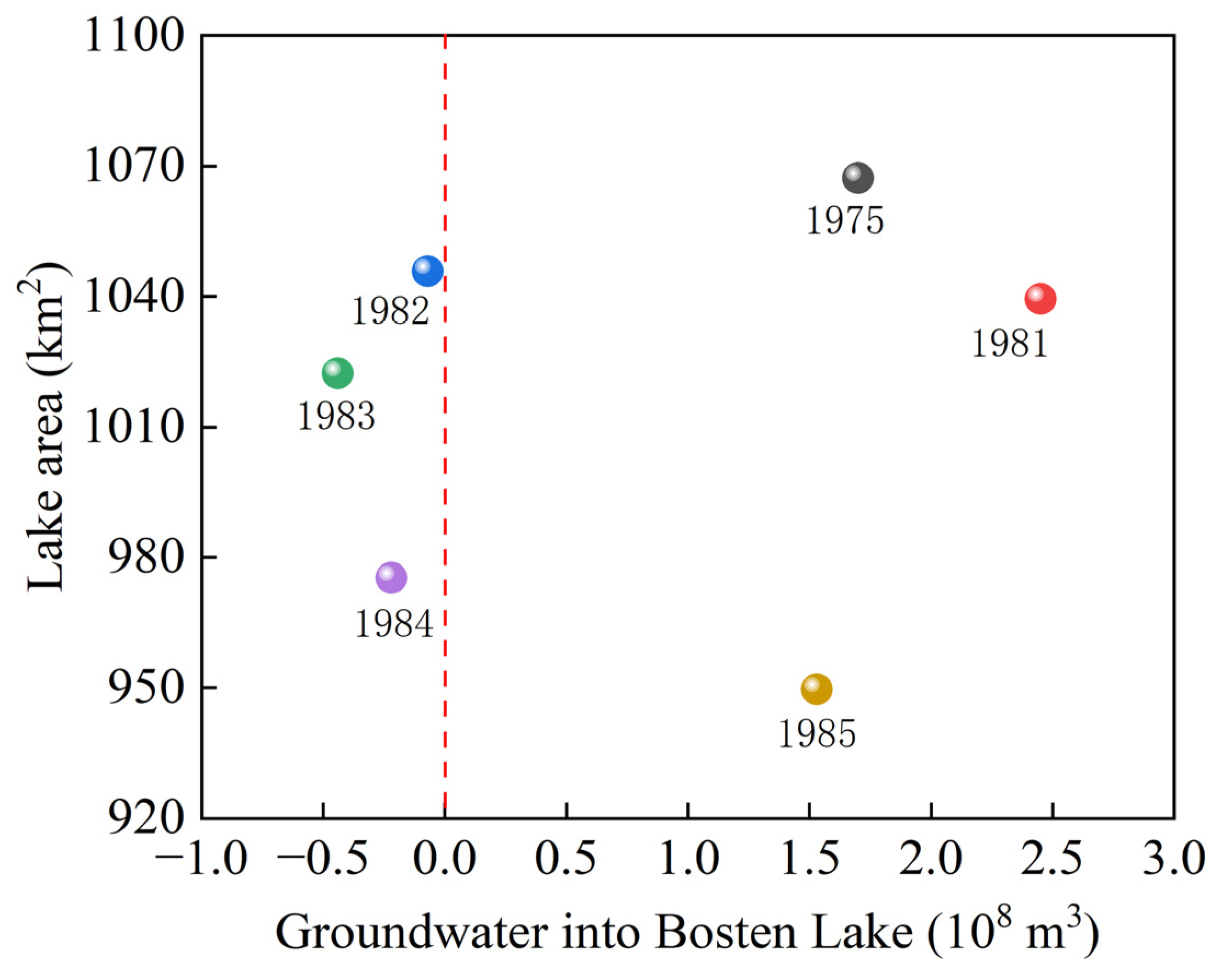

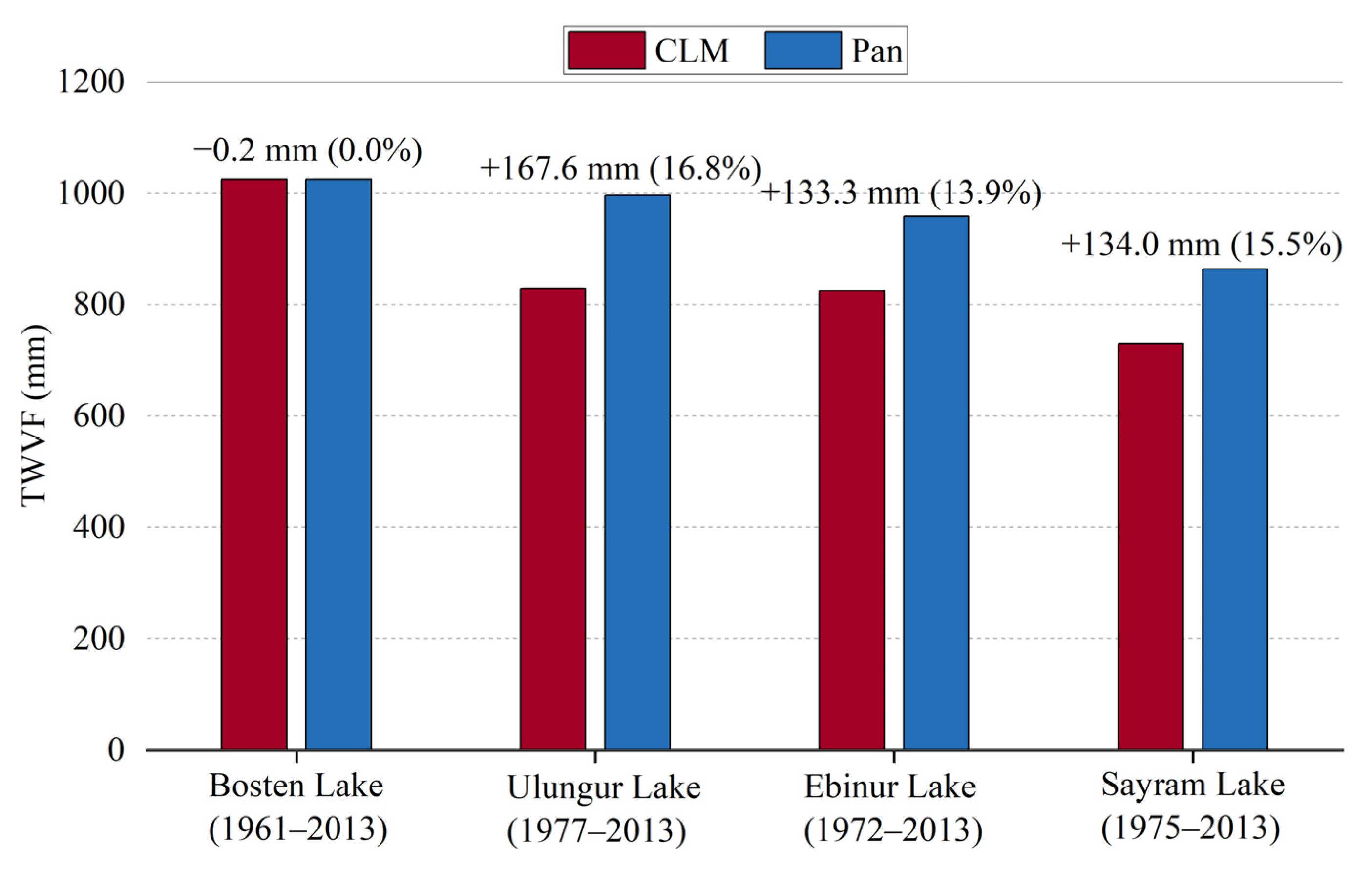
| Lake Name | Altitude (m) | Winter Temperature (°C) | Annual Ice Cover Length (days) | Area (km2) | Water Volume (108 m3) | Lake Depth (Average vs. Maximum, in meters) | Water Retention (days) | Salinity (g L−1) |
|---|---|---|---|---|---|---|---|---|
| Bosten Lake | 1052 | −8.4 | 77 | 1047.8 | 75 | 8 vs. 16 | 3061 | 1.05 [13] |
| Ulungur Lake | 480 | −17.0 | 128 | 944.9 | 59 | 8 vs. 17 | 3403 | 1.98 [14] |
| Ebinur Lake | 189 | −12.5 | 112 | 872.1 | 8 | 1.4 vs. 2.8 | / | 142.74 [15] |
| Sayram Lake | 2072 | −12.5 | 147 | 458.6 | 210 | 56 vs. 92 | / | 3.58 [16] |
| Lake Name | Phase | Lake Area | River Inflow | TWVF | Sublimation | Precipitation | River Outflow |
|---|---|---|---|---|---|---|---|
| Bosten Lake | First phase (1961–1987) | 1065.56 | 22.24 | 10.44 | 0.39 | 0.73 | 7.55 |
| Second phase (1988–2002) | 1050.97 | 29.89 | 10.28 | 0.63 | 0.95 | 10.26 | |
| Difference from previous phase | −14.59 | 7.66 | -0.16 | 0.24 | 0.22 | 2.71 | |
| Third phase (2003–2013) | 999.84 | 24.40 | 12.01 | 0.39 | 0.72 | 11.42 | |
| Difference from previous phase | −51.13 | −5.49 | 1.73 | −0.24 | −0.23 | 1.16 | |
| Ulungur Lake | First phase (1977–1990) | 906.48 | 9.26 | 7.69 | 0.39 | 0.95 | / |
| Second phase (1991–2013) | 941.61 | 10.00 | 7.78 | 0.47 | 1.29 | / | |
| Difference from previous phase | 35.13 | 0.74 | 0.09 | 0.08 | 0.34 | / | |
| Ebinur Lake | First phase (1980–1997) | 532.97 | 16.55 | 4.41 | 0.23 | 0.60 | / |
| Second phase (1998–2003) | 681.89 | 20.17 | 5.47 | 0.31 | 0.89 | / | |
| Difference from previous phase | 148.92 | 3.62 | 1.06 | 0.08 | 0.29 | / | |
| Third phase (2004–2016) | 521.84 | 18.16 | 4.29 | 0.24 | 0.77 | / | |
| Difference from previous phase | −160.05 | −2.01 | −1.18 | −0.07 | −0.12 | / | |
| Sayram Lake | First phase (1975–1990) | 455.43 | / | 3.43 | 0.43 | 0.88 | / |
| Second phase (1991–2013) | 459.42 | / | 3.33 | 0.46 | 1.26 | / | |
| Difference from previous phase | 3.99 | / | −0.10 | 0.03 | 0.37 | / |
Disclaimer/Publisher’s Note: The statements, opinions and data contained in all publications are solely those of the individual author(s) and contributor(s) and not of MDPI and/or the editor(s). MDPI and/or the editor(s) disclaim responsibility for any injury to people or property resulting from any ideas, methods, instructions or products referred to in the content. |
© 2023 by the authors. Licensee MDPI, Basel, Switzerland. This article is an open access article distributed under the terms and conditions of the Creative Commons Attribution (CC BY) license (https://creativecommons.org/licenses/by/4.0/).
Share and Cite
Cao, Y.; Fu, C.; Yang, M.; Wu, H.; Wu, H.; Zhang, H.; Xia, Y.; Zhu, Z. Exploring the Drivers for Changes in Lake Area in a Typical Arid Region during Past Decades. Water 2023, 15, 3354. https://doi.org/10.3390/w15193354
Cao Y, Fu C, Yang M, Wu H, Wu H, Zhang H, Xia Y, Zhu Z. Exploring the Drivers for Changes in Lake Area in a Typical Arid Region during Past Decades. Water. 2023; 15(19):3354. https://doi.org/10.3390/w15193354
Chicago/Turabian StyleCao, Yang, Congsheng Fu, Mingxiang Yang, Huawu Wu, Haohao Wu, Haixia Zhang, Ye Xia, and Zichun Zhu. 2023. "Exploring the Drivers for Changes in Lake Area in a Typical Arid Region during Past Decades" Water 15, no. 19: 3354. https://doi.org/10.3390/w15193354
APA StyleCao, Y., Fu, C., Yang, M., Wu, H., Wu, H., Zhang, H., Xia, Y., & Zhu, Z. (2023). Exploring the Drivers for Changes in Lake Area in a Typical Arid Region during Past Decades. Water, 15(19), 3354. https://doi.org/10.3390/w15193354







